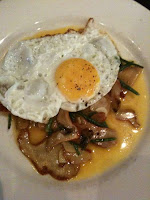
|
image via alanyau.cn
|
Alan Yau, the pioneer of the
Wagamama chain of noodle shops, opened the original
Hakkasan in London in 2001. In many ways, it was a more contemporary take on the strategy coined by Michael Chow of
Mr. Chow in the late 1960's and 70's: make Chinese food upscale, sexy and maybe a bit more accessible to Westerners. It worked phenomenally well, and has been a continuing success: Hakkasan London received a Michelin star in 2003, and is listed in the Pellegrino "
World's 50 Best Restaurants." We were there a few years ago, and it's easy to see why it's popular. It's a slick-looking place, all black lacquer and silk, dimly but dramatically lit, carved up by wooden screens into intimate little spaces like a really elegant opium den; and the food was high quality, prepared well, and somewhat adventurous without being too intimidating. A good, fun place, though I have my doubts it really belongs on a list of the world's 50 best restaurants.
The
Miami Hakkasan, the first U.S. outpost of the brand (Yau actually sold much of his stake in Hakkasan in 2008 but continues to be involved), opened in the
Fontainebleau hotel in April of this year, riding the wave of foreign invaders who had plotted their strategies before the bottom fell out of the economy (Gotham Steak and Scarpetta, both also in the Fontainebleau; Mr. Chow and his evil twin Philippe; BLT Steak, Eos ...). The entrance to the Miami restaurant is not nearly as dramatic as its London cousin, which is sort of hidden away on a side street and takes you down into a mysterious basement space. Instead, you have to wind your way down a long but nondescript hallway nearly into the bowels of the hotel, then up an elevator to the fourth floor. But once you get there, the look and feel of the place effectively duplicate the cool vibe of the London original.
The menu likewise is pretty similar, if slightly shorter, than the London version. The most notable difference is that with the Miami Hakkasan only being open for dinner, it does not include the
extensive dim sum menu available in London at lunchtime. That, my friends, is a serious bummer. But there are still a few dim sum offerings on the dinner menu, including a dim sum platter (featuring 2 each of 4 different dumplings) and grilled Shanghai dumplings. We tried both, as well as a duck salad, crispy Szechuan shredded beef, jasmine tea smoked chicken, Singapore noodles, stir-fried gai lan with salted fish and chili, and spring onion fried rice.
There is an obvious discipline and precision to the cooking here. When the lid of the steamer basket was removed from the dim sum platter, the dumplings looked like little jewels on display - shrimp har gow, green-skinned chive and shrimp dumplings, vegetable dumplings, and scallop dumplings topped with a sprinkle of golden tobiko each positively glistened. The fillings were fresh and steaming hot, and the dumpling skins were among the finest I've had, translucently thin and slippery but still sturdy enough not to fall apart upon being picked up. The "grilled Shanghai dumplings" were potstickers, not xiao long bao (soup dumplings), and were possibly the greatest bargain on the menu at $8 for an order of 6 (particularly compared to the $24 for the 8-piece dim sum platter). These were again expertly prepared, crispy on the bottom, steamy and soft on top, though I prefer a pork filling to the blander chicken they offer (there is also a vegetable option). A ginger-spiked black vinegar sauce helped perk these up some.
The crispy duck salad is listed among the appetizers (and seems pricy there at $22) but the portion we received could easily have served as a main course. My guess is that this is the duck meat left over once the skin is harvested for Peking duck, shredded and crisped briefly in a wok, and tossed with some greens, pea shoots and pine nuts. It was definitely my kind of salad, with about a 3:1 ratio of meat to greens.
The jasmine tea-smoked chicken had dark soy-lacquered skin and tender, delicately smoke-infused flesh; it was chopped in Chinese-style chunks but also nicely taken off the bone. The crispy "Szechuan" shredded rib eye was beautiful to look at but a disappointment to eat. The plate bore an artfully assembled tangle of strips of beef (more in the candied style of an orange beef than any Szechuan dish I've had), along with batons of mango and big slivers of red onion. But it had an awful lot more of the latter two than of the beef, and tasted much more of sweet than of any spice. The best part was probably the sticky cashews garnishing it, which had been rolled in sesame seeds (Little Miss F quickly snagged most of these).
The timidity of the Szechuan beef was all the more surprising because the gai lan (Chinese broccoli) dish we had clearly shows the kitchen does not shy from bold flavors. The gai lan, their stems slivered so they bent in a graceful tangle like the beef dish, were stir-fried with dry chiles, slivered garlic and thin crispy shards of aggressively salted dried fish. This was salt with an exclamation point, almost inedibly so, but clearly intentional and presumably a variation on a traditional recipe. The Singapore vermicelli were more moist and less curry-spiced than most versions I've had, but still quite good, speckled with green onion, slivers of red pepper, stir-fried scrambled egg, and a few shrimp here and there. The spring onion fried rice was unexceptional but provided nice ballast for the rest of the meal.
Desserts were unremarkable other than for their cost ($11). Little Miss F had a passionfruit-topped cheesecake which was paired with a bracingly sour passionfruit sorbet; Frod Jr. (predictably) had a warm chocolate cake which was indistinguishable from any other rendition.
Service was quite attentive and knowledgeable, with something of a team approach and everyone seeming to know the menu well. The only negative here was that, after having been seated at 6:30 p.m., it became fairly obvious towards the end of our meal that they were really pushing to turn the table by 8:00 p.m. I don't think I've ever been asked (seriously, with no "cute" mocking tone) "You don't want dessert, do you?" Truth was, I would have been perfectly happy to have gone and tried the gelato place in the Fontainebleau instead of ordering dessert; I think the kids did so just to spite the waiters who were trying to give us the bum's rush.
Overall I really enjoyed the food at Hakkasan (excepting the Szechuan beef and the desserts), but the price-to-value ratio is maddeningly inconsistent here. The grilled Shanghai dumplings are perfectly reasonable at $8 for an order of 6, and seem like a fantastic bargain compared to the 8-piece dim sum platter that costs three times as much. The duck salad would have been an expensive appetizer for $22, but was really a main course portion (and fairly priced for what you got). Meanwhile, the jasmine tea-smoked chicken for $19 may have been three times as much meat as the miserly strands of beef bedecked among the onions and mangoes in the $36 Szechuan beef. Sampling from their cocktail menu (at $14 a pop) will also quickly dispel any hope of coming away without serious financial damage, though a quick glance at the wine list suggested that there were actually many interesting options in a reasonable price range.
Which reminds me of one other interesting little touch. Our kids ordered lemonades, and what they got was a really unexpected surprise. Little Miss F's eyes lit up after her first sip and she exclaimed, "This tastes like key lime pie!" And indeed it did. A closer inspection revealed what looked to be freshly scraped vanilla seeds floating near the top of the drink. That is one fancy lemonade.
Clearly, Hakkasan is not the place to go for cheap dim sum or cheap anything, for that matter. But I remain convinced that if you order carefully and watch what you drink, you can actually have a very good meal and not break the bank. Even if you're not so careful, you'll probably enjoy it right up to the moment that the bill arrives.
Hakkasan
4401 Collins Avenue
Miami Beach, FL 31340
786.276.1388

 Hot on the heels of the "Brooklyn Water Bagel Co.," here's another entrant into the bagel brouhaha: Brooklyn Bagels, coming - sooner or later, like so many other places announce - to Midtown Miami. The press release says the owner, Ashraf Sahaltout, has "roots in Brooklyn for generations. " I could not, despite inquiry, get any info as to what NY delis he's been associated with.
Hot on the heels of the "Brooklyn Water Bagel Co.," here's another entrant into the bagel brouhaha: Brooklyn Bagels, coming - sooner or later, like so many other places announce - to Midtown Miami. The press release says the owner, Ashraf Sahaltout, has "roots in Brooklyn for generations. " I could not, despite inquiry, get any info as to what NY delis he's been associated with.






